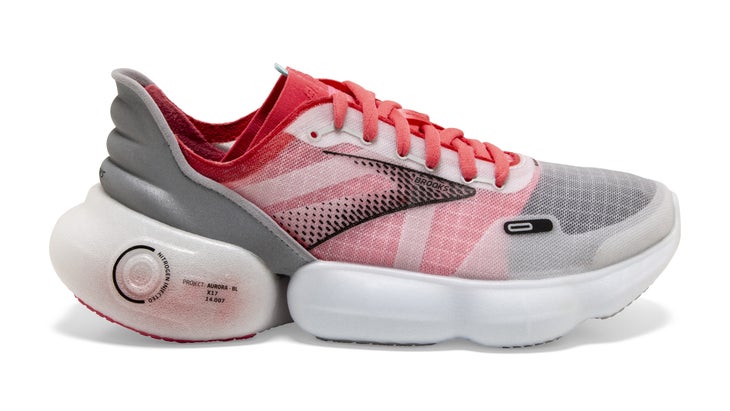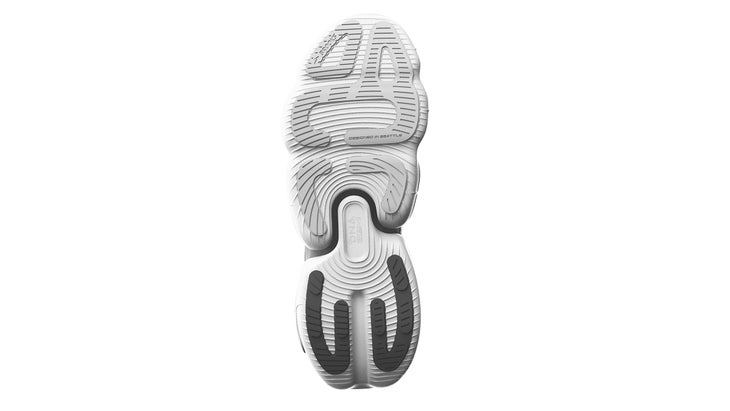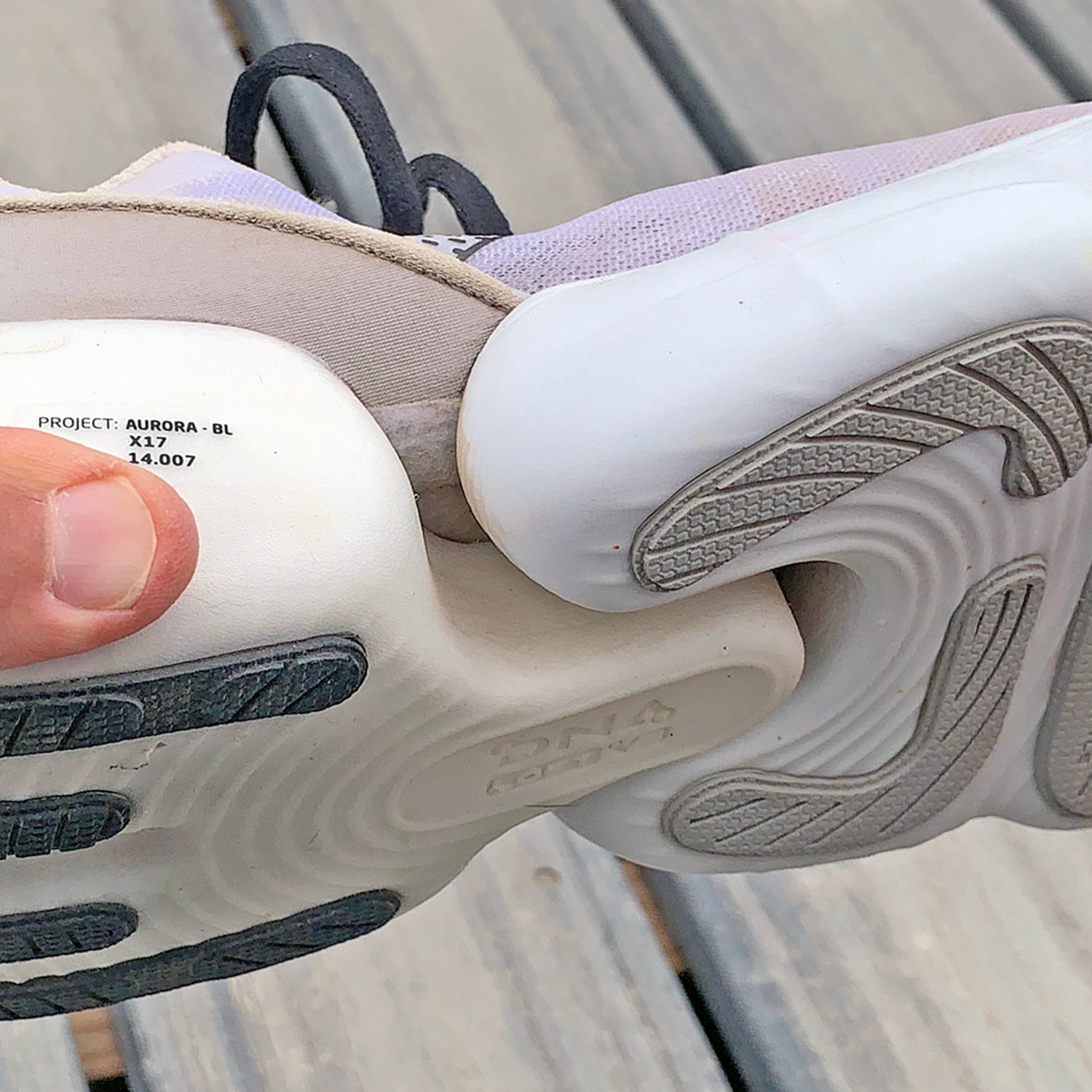There’s a route near my home that I jokingly refer to as “The Hardest Run in Boulder.” It’s a mostly flat circumnavigation of the Boulder Reservoir that measures just 5.3 miles long. But for a runner like me, who’s more comfortable clamoring up and down steep rocky mountain trails than cranking out fast flat miles, the run always feels disproportionately difficult.
Roughly two years ago, I ran the loop wearing the then-limited edition Aurora-BL—“BL” stands for BlueLine, Brooks Running’s shoe development subset that brings prototypes to market to test new innovations. I was hoping that the massive amounts of cushioning, instant step-in comfort, and interesting decoupled sole would make the “Hardest Run in Boulder” not feel so hard. And that day, two years ago, it did. My legs felt lighter, my stride felt smoother. I actually ran at a remarkably spry pace down the final stretch of flat, dirt road, and felt much less wrecked afterward than I usually do.
Further testing had me so excited about the shoe that colleague Cory Smith and I considered including it in a round-up of “Best Road Running Shoes” in the biannual ���ϳԹ��� Buyer’s Guide. But, being limited-edition, the 25,000 pairs of Aurora-BL sold out before we could write it up.
Then, in March of this year, I was thrilled to see the Aurora-BL re-appear in Brooks’ regular line, next to franchise shoes like the Glycerin 20 and Ghost 15. I got another pair and decided to take a deep dive into the tech behind this innovative shoe’s smooth ride.

MSRP: $200
Weight: 8.5 oz (men’s); 7.6 oz (women’s)
Stack Height: 37 mm heel/ 31 mm forefoot (6 mm drop)
Why the Aurora-BL Is Different
The most unique, and significant feature of the Aurora-BL is its funky, decoupled outsole. Decoupling the sole—separating the cushioning under the forefoot from the cushioning under the heel with a flex groove that extends all the way through the sole (you can essentially bend the shoe in half, front-to-back)—allows the foot to flex naturally. During the stride, the front and back of the foot move independently from one another.
Other shoes have had outsoles that were decoupled to varying degrees, including the Salomon Predict, Adidas models that utilized what they called a “Torsion Bar” in the early ‘90s, the INOV-8 Ultra-G models, the Brooks Neuro, and early versions of the Brooks Pure line. But none in quite the same way.
Rather than a straight cut across the midfoot, the groove on the Aurora-BL swoops around three-quarters of a loop on its way from left to right, like a river in a desert canyon. Nikhil Jain, who leads the Brooks BlueLine team and guided the Aurora-BL project from concept to market, says that this puzzle-piece configuration where heel and forefoot cushioning come together keeps the shoe from twisting side to side, without interfering with the independent movement of the front and back of the shoe and the foot.
And that independent movement is a good thing. “When you allow the shoe to move with the foot, lots of beneficial things happen,” says Jay Dicharry, a biomechanical analysis expert and professor of sports medicine at Oregon State University at Cascades. “You have 26 bones in your feet that need to move a lot, especially in your midfoot. So if you have a shoe that moves with your foot—the midsole, the outsole, the upper—you get really great results in terms of how the body behaves.”
Dicharry explains that when a shoe is “too stiff underfoot,” the insole of the shoe pulls away from the sole of the foot “and you don’t get uniform input.” You lose the sensory feedback from your natural footstrike.
He points to a he helped conduct which examined how shoe upper design can affect performance. “When the upper conforms to the shape of your foot better, we see better running, cutting, and jumping performance,” he says. “Any shoe that’s more mobile moves with your foot, and that’s a step in the right direction.”
It’s not just the decoupling that makes this shoe different. Shoe nerds might automatically think, “How is this any different from a Nike Free?” Nike Free shoes, which debuted in 2004 at the beginning of the minimalist movement, have multiple independent pods underfoot, all with deep flex grooves, intended to allow the foot to move, well, freely.
While they share midfoot flexibility, the Aurora-BL has maximal cushioning (with a stack height of 37 millimeters below the heel, 31 millimeters under the forefoot), but even the thickest Free leans minimal. And that cushioning, both in the first version of the Aurora-BL released two years ago and in the current one, is a nitrogen-infused, EVA/rubber blend (Brooks’ DNA Loft v3), which is now also in the current Brooks Glycerin, Hyperion, and Caldera models. It’s a lighter, springier, more responsive foam than a traditional EVA, making the ride less squishy while still being highly forgiving.
The fit is somewhat unique as well, with a thin, waffle-weave inner bootie providing a secure midfoot wrap. According to Jain, the secure hold is designed to offset the feeling of concern someone might have about their foot slipping on top of a decoupled/freely moving outsole. “It allows the foot to be closely planted on the midsole. But you can still get the effect that you need from the decoupling.”

Who the Aurora-BL Is For
Dicharry maintains that the decoupling of a shoe like the Aurora-BL influences biomechanics in a positive way, but admits that easing into a shoe with major decoupling should be a gradual affair. That is to say that if you’ve been running in a traditional stability shoe, your foot is likely deconditioned, and you’ll need to build up strength. “But if you have someone that’s got relatively good foot control,” he says, “I’d think they’d do extraordinarily well with a more mobile shoe. It’s not the fact that the shoe is less stable, but the fact that the shoe gives them sensory input.”
Unlike carbon-plated shoes—which, Dicharry says, work like “mini-trampolines” under the foot, launching you forward rather unnaturally—decoupled cushioning mimics the anatomy of the heel and forefoot. And while carbon-plated shoes have their place and aren’t going away anytime soon (PR, anyone?), appears to be growing that they stress your feet and ankles in unique ways and you probably shouldn’t wear them every day.
The Aurora-BL has similarities to the max-cushioned, high-rebounding, plate-less Nike Invincible 3. I reach for one or the other when I feel particularly banged up from running workouts, or from life in general. I like them both for their forgiving, responsive cushioning and wide platforms that make me feel supported.
But the Aurora-BL has a different ride from the Nike Invincible 3. The Brooks seems to encourage a smoother stride, whether I’m plodding along and heel striking (as I do), or picking up the pace and landing more midfoot. To that, I point to the decoupling.
“We have the research to know that, irrespective if you’re a heel striker, midfoot striker, or a forefoot striker, at some point in time your heel and the forefoot can work slightly exclusive of each other,” says Jain. He says that the decoupling—combined with the cushioning—aim to transition you through the stride “as seamlessly as possible.”
Test 2.0
I started re-testing the newly released, inline Aurora-BL on short runs in my neighborhood, enjoying the ride all over again. But to really see how I felt about it, I put it on for another loop around the Boulder Reservoir. This time, the run was after talking with Dicharry and Jain in-depth about what the shoe intended to do for me: cushion, smooth out my stride, give me sensory input whether I am heel-striking or midfoot striking, and do good things for my body.
I ran smoothly, albeit slowly, around that damn loop. I picked up the pace a couple times, down flat dirt sections and across a segment on pavement. I enjoyed the view of the snow-capped Indian Peaks off in the distance, far behind the still, reflective water of the reservoir (and decided the run itself isn’t all that bad). And I felt good. I felt like I want the parts of my feet to move independently all the time.
I’m not sure if decoupling—with cushioning and great arch hold and fit—will infiltrate across the shoe industry like minimal shoes, maximal shoes, and carbon-plated models have in various waves. But I’m thinking there’s a solid case for more models that allow this natural movement.
Until that happens, I’ll keep enjoying the Aurora-BL. Jain says that the shoe might go away again. But don’t fear: It’ll reappear as a newly-named model within the Glycerin line.
��


